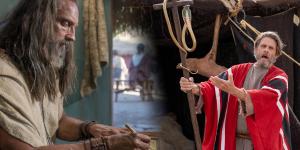You are here
Why Did Christ Appear to Two Disciples on the Road to Emmaus?

Luke 24:13, 15
The Know
Shortly after Jesus’s Resurrection, still relatively few had seen the risen Lord or heard the news that He had indeed risen from the grave. The first witnesses to the Resurrection were women who went to the tomb early in the morning, and when they “returned from the sepulchre, [they] told all these things unto the eleven, and to all the rest” (Luke 24:9).
Among these disciples with the remaining eleven Apostles were two that “went that same day to a village called Emmaus,” about seven miles west of Jerusalem. As they traveled, “they talked together of all these things which had happened” over the past few days and “communed together and reasoned” about what they had heard from the women earlier that day (Luke 24:13–15; cf. Mark 16:12). S. Kent Brown observes, “The point of discussion between the two disciples, of course, has to do with the empty tomb, the fact of which they and the others cannot fathom.”1 Furthermore, the verb translated as “reasoned” carries a dual meaning of “to discuss” and “to dispute or debate.” Thus, while the two disciples were traveling to Emmaus, it is possible that their discussion involved lively debates of how to make sense of “the persistent report from the women” and “Jesus’ unforeseen death.”2
It was during this time that “Jesus himself drew near, and went with them” (Luke 24:15). With this statement, Luke begins to emphasize the reality of Jesus’s Resurrection through the deliberate use of witnesses to Jesus’s physical presence. Using an emphatic pronoun translated as “himself,” Luke uses a verb that “underscores the approaching experience as both a designed disclosure to the two disciples and a planned part of his resurrection appearances.”3 Like the other Gospel accounts, Luke is adamant in pointing out how many people from varying backgrounds testified of the Savior’s Resurrection to demonstrate the authenticity of this miracle of miracles.4
However, the disciples did not recognize Jesus at first. Luke records that “their eyes were holden that they should not know him,” (Luke 24:16), implying “a continual restraining of sight” by someone else, namely God.5 Significantly, the Joseph Smith Translation of this verse adds that the disciples’ eyes “were holden, or covered.” Therefore, it appears that these two disciples were not yet ready to behold the resurrected Lord in His full glory, rather viewing Him as though through a veil, seeing Him as he had looked as a mortal man. Apparently, resurrected beings can appear to us and yet look like normal mortals due to some spiritual filter that covers our eyes.
When these disciples were asked why they were sad, they unwittingly told Jesus that they had actually been pondering on Him and His ministry. In their response, one can sense the frustration they were experiencing as they tried to grapple with everything that had just happened:
Concerning Jesus of Nazareth, which was a prophet mighty in deed and word before God and all the people: and how the chief priests and our rulers delivered him to be condemned to death, and have crucified him. But we trusted that it had been he which should have redeemed Israel: and beside all this, to day is the third day since these things were done. Yea, and certain women also of our company made us astonished, which were early at the sepulchre; and when they found not his body, they came, saying, that they had also seen a vision of angels, which said that he was alive. And certain of them which were with us went to the sepulchre, and found it even so as the women had said: but him they saw not. (Luke 24:19–24)
“Implicit in their words,” Brown observed, “lies an incorrect, widespread notion that the Messiah is to carry out an expected deliverance” from Roman captivity.6 In fact, the verb translated as “should have redeemed” employed by these two disciples “has to do with Jesus rescuing Israel as a people by military might rather than him paying a ransom for sins or paying a price to bring about salvation, as in other passages.”7 Relying on these mistaken notions of who the Christ would be was undoubtedly a large part of why these disciples simply identified Him now as “a prophet mighty in word and deed.” Yet, these two men are unable to reconcile their misplaced ideas with recent events.
Jesus, however, responds with an appeal to the scriptures: “O fools, and slow of heart to believe all that the prophets have spoken: ought not Christ to have suffered these things, and to enter into his glory? And beginning at Moses and all the prophets, he expounded unto them in all the scriptures the things concerning himself” (Luke 24:25–27). Significantly, it is here that the two disciples’ understanding of the scriptures takes on new meaning and the men are finally able to grasp the true meaning of many scriptures.8 Jesus thereby corrected these false understandings and taught them how to properly recognize Him in the scriptures.
Finally, once the three entered Emmaus, the two disciples were so moved that they invited Jesus to spend the night with them (see Luke 24:28–29). Having entered the home of one of the two disciples, Jesus “took bread, and blessed it, and brake, and gave to them” in an evening meal (Luke 24:30). This scene evokes imagery of the Last Supper and the institution of the sacrament, which was to be performed in remembrance of Jesus. Brown observes, “Although the Savior does not speak words that turn the meal into the sacrament, the meal becomes sacramental or holy in character because of who he is.”9
Now that the disciples had heard Jesus preach from the scriptures and had received a symbol of His crucified and resurrected body, “their eyes were opened, and they knew him” (Luke 24:31). They were now able to discern the full glory and presence of the Lord, becoming two important witnesses to the reality of His glorious Resurrection. Having now learned the true nature of the Messiah and seen Him with their eyes, they could effectively go out and spread His gospel.
The Why
One of the greatest challenges many early Christians experienced during this time was reconciling their own previous expectations of who the Messiah would be with what they had personally experienced. Like the disciples on the road to Emmaus, many initially believed that Jesus would come first and foremost as a conqueror who would claim the Davidic throne and redeem Israel from Roman rule. Consequently, they were understandably left confused when Jesus willingly allowed Himself to be crucified by wicked men, even though Jesus had frequently prophesied about His death and Resurrection.10
Rather than fulfil the militaristic expectations of many of the Jewish population, Jesus first came as the conqueror not of Rome but of death and sin. Jesus makes it clear that all the prophets who have ever lived testified of Him, both of His mortal ministry and of His millennial reign. In short, all scripture is focused on Jesus Christ and His atoning sacrifice.
Such is expressed clearly in the Book of Mormon. “And we talk of Christ,” Nephi recorded, “we rejoice in Christ, we preach of Christ, we prophesy of Christ, and we write according to our prophecies, that our children may know to what source they may look for a remission of their sins” (2 Nephi 25:26). Just as Nephi’s entire view of the scriptures had dramatically shifted as the prophet saw a vision of the Savior (see 1 Nephi 11–13),11 so too did the ancient disciples in the Old World begin to understand the fullness of the scriptures as they talked with and saw the resurrected Jesus.
Modern readers of the scriptures will occasionally have to follow the example of the two disciples on the way to Emmaus. As we each come to the Lord with our own viewpoints and ideas, we can look to their example for the humility to put aside our own ideas in favor for the truth of the gospel. As we study the scriptures, we can come to know Jesus Christ and His will more fully, and like the disciples at Emmaus, we too will be able to ask “Did not our heart burn within us?” as we approach the Lord in all sincerity of heart and receive His presence even though we know it not (Luke 24:32).
Further Reading
S. Kent Brown, “Luke Chapter 24,” in The Testimony of Luke (Provo, UT: BYU Studies, 2014), 1103–1142.
Julie M. Smith, “The Resurrection,” in New Testament History, Culture, and Society: A Background to the Texts of the New Testament, ed. Lincoln H. Blumell (Provo, UT: Religious Studies Center, Brigham Young University; Salt Lake City, UT: Deseret Book, 2019), 377–392.
- 1. S. Kent Brown, The Testimony of Luke (Provo, UT: BYU Studies, 2014), 1116.
- 2. Brown, Testimony of Luke, 1116.
- 3. Brown, Testimony of Luke, 1117.
- 4. See Book of Mormon Central, “Why Are the Gospel Accounts of the Resurrection Credible? (Luke 24:5–6),” KnoWhy 665 (April 4, 2023). Brown, Testimony of Luke, 1117–1118, similarly identifies Cleopas, one of these two disciples (and who also may have also been Jesus’s uncle), as the eyewitness who gave Luke the information needed to add this account to his record.
- 5. Brown, Testimony of Luke, 1117.
- 6. Brown, Testimony of Luke, 1119.
- 7. Brown, Testimony of Luke, 1119.
- 8. A similar experience is recorded in Acts 8:26–40, wherein Philip baptizes an Ethiopian eunuch after opening to him the scriptures (specifically Isaiah 53:7–8).
- 9. Brown, Testimony of Luke, 1124.
- 10. See, for example, Matthew 16:21–23; 17:22–23; 20:17–19; Mark 8:31–32; 9:30–32; 10:32–34; Luke 9:21–22; 9:43–45; and 18:31–34.
- 11. See, for example, John W. Welch, “Getting through Isaiah with the Help of the Nephite Prophetic View,” in Isaiah in the Book of Mormon, ed. Donald W. Parry and John W. Welch (Provo, UT: Foundation for Ancient Research and Mormon Studies, 1998), 19–45.
KnoWhy Citation
Related KnoWhys
Subscribe
Get the latest updates on Book of Mormon topics and research for free





